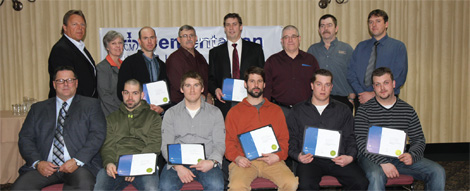 Miners and mineral processing operators have sets of elite skills and knowledge that can now be nationally certified and recognized across Canada thanks to an innovative Canadian Mining Credentials Program being introduced by the Mining Industry Human Resources (MiHR) Council.
Miners and mineral processing operators have sets of elite skills and knowledge that can now be nationally certified and recognized across Canada thanks to an innovative Canadian Mining Credentials Program being introduced by the Mining Industry Human Resources (MiHR) Council.
Over the past six years, MiHR has been coordinating a collaborative effort by mining sector employers, employees, educators and other stakeholders to develop a program that will recognize the skills, competencies and knowledge of mine operations and maintenance workers. Unlike the trades, skilled workers in these occupations have never before been awarded an industry-recognized credential that supports mobility and retention within the mining workforce.
It is a proactive and encouraging step MiHR and partners are taking to help keep the Canadian mining industry at the forefront of a complex and challenging global market.
“From industry’s point of view, there’s a huge challenge coming over the next 10 years looking for appropriately skilled workers to help the mining industry move forward in terms of growing and maintaining the strength and position of Canada in the global mining market,” said Barbara Kirby, MiHR’s senior director for workplace development. “Other research MiHR has done has identified this shortage of skilled workers as a key challenge to the industry over the next 10 years. At the same time, workers in the occupations we’re looking at certifying right now have for a number of years expressed a desire to have the skills and knowledge they develop over the course of their careers recognized in Canada and by industry. This certification program is looking at addressing both of those needs.”
Assessing new hires
Without a formal credentialing framework for these jobs, employers could struggle to evaluate the qualifications of experienced candidates and could end up wasting time and resources retraining new hires in areas where they have already demonstrated competency in the workplace. The goal of the credentials program is to increase recognition of skills and competencies, support worker mobility and create consistent, quality training for the industry in Canada. The credentials program isn’t a training program. Nor is it designed to replace any provincial programs such as the common core program.
“The change is about the way we view these occupations. We’re talking about workers who develop an extensive toolkit of skills and operate multi-million dollar equipment in very complex working environments,” Kirby said. “Traditionally, these three occupations haven’t been recognized as occupations in their own right. They get lumped into semi-skilled and undesignated occupations. The jobs are highly skilled and require specific knowledge about safety and technical operations of a mine. This program provides recognition for these workers.”
In 2010, MiHR launched a pilot program at seven mines across Canada. Taking part were Xstrata Zinc’s Brunswick Mine in Bathurst, New Brunswick; Rio Tinto’s Diavik Diamond Mine in the Northwest Territories; and Teck Coal’s Greenhills Operation, Northgate Minerals’ Kemess South Mine and Teck Resources’ Highland Valley Copper in British Columbia. Cementation Canada Inc. employees at Vale’s Totten Mine in Sudbury and HudBay Minerals’ Trout Lake Mine in Manitoba also participated.
The pilot project was a success and gave new insight to the MiHR Council as it moves forward with the program.
“We’ve received positive signals from a wide variety of employers and employees,” Kirby said. “This program builds on what is already happening at individual mine sites across the country.”
Workers who have trained at one mine site will have their training recognized by another employer.
Miner mobility
“Our data says workers will work at as many as seven mine sites in their career. Every time they start a new job, they go back to the bottom and do all their training again. It can get frustrating for workers,” said Kirby. “What the program is trying to do is create a common understanding of what are the basic skill sets required to do these occupations and what are the more advanced skills required so workers moving from one workplace to the next don’t have to start all over again.”
The program is strictly voluntary and there is no current or future plan to have it ensconced in a regulatory requirement. Individuals who wish to be certified through the program must do so with the consent of their employer as the assessment process is undertaken by an employer-appointed workplace assessor.
There is tremendous motivation for employers and employees to take advantage of the credentials program.
“This will really help the industry without requiring an enormous change in the way we’ve done things all along in mining,” Kirby said. “The feedback we have received from the folks who have been through the pilot program is they’re able to see a clear path moving forward. They’re able to identify areas in which they might need further training or professional development. It gives people who might be considering a career in mining a clear future of what the jobs entail and what are the opportunities to grow their package of skills. It’s a lot easier for an employer to evaluate if a potential new employee can do the job and get that worker operating effectively much faster and at a reduced cost for training.”
With the pilot project over, MiHR is moving toward full implementation
“We’re in the process of reviewing an external evaluation report,” said Kirby. “The plan moving forward is for us to develop a business plan and sustainability plan for making this certification available to workers in these occupations across Canada as early as the fall of this year. We’ll be taking it to our board of directors and asking for their approval to scope this program out nationally and make it available.”


